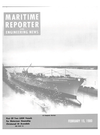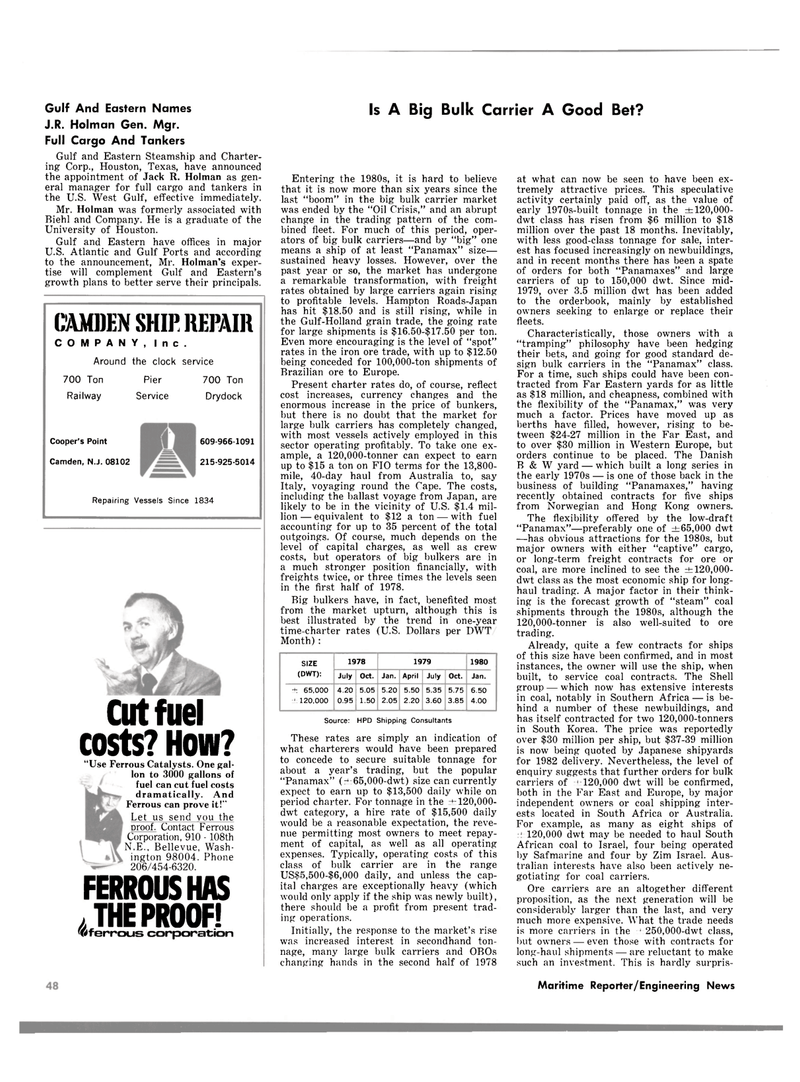
Page 46: of Maritime Reporter Magazine (February 15, 1980)
Read this page in Pdf, Flash or Html5 edition of February 15, 1980 Maritime Reporter Magazine
Gulf And Eastern Names
J.R. Holman Gen. Mgr.
Full Cargo And Tankers
Gulf and Eastern Steamship and Charter- ing Corp., Houston, Texas, have announced the appointment of Jack R. Holman as gen- eral manager for full cargo and tankers in the U.S. West Gulf, effective immediately.
Mr. Holman was formerly associated with
Biehl and Company. He is a graduate of the
University of Houston.
Gulf and Eastern have offices in major
U.S. Atlantic and Gulf Ports and according to the announcement, Mr. Holman's exper- tise will complement Gulf and Eastern's growth plans to better serve their principals.
Is A Big Bulk Carrier A Good Bet?
CAMDEN SHIP REPAIR
COMPANY, Inc.
Around the clock service 700 Ton
Railway
Pier
Service
Cooper's Point
Camden, N.J. 08102 700 Ton
Drydock 609-966-1091 215-925-5014
Repairing Vessels Since 1834
Cut fuel costs? How? "Use Ferrous Catalysts. One gal- lon to 3000 gallons of fuel can cut fuel costs dramatically. And
Ferrous can prove it!"
Let us send you the proof. Contact Ferrous
Corporation, 910 - 108th
N.E., Bellevue, Wash- ington 98004. Phone 206/454-6320.
FERROUS HAS , THE PROOF! '©ferrous corporation
Entering the 1980s, it is hard to believe that it is now more than six years since the last "boom" in the big bulk carrier market was ended by the "Oil Crisis," and an abrupt change in the trading pattern of the com- bined fleet. For much of this period, oper- ators of big bulk carriers—and by "big" one means a ship of at least "Panamax" size— sustained heavy losses. However, over the past year or so, the market has undergone a remarkable transformation, with freight rates obtained by large carriers again rising to profitable levels. Hampton Roads-Japan has hit $18.50 and is still rising, while in the Gulf-Holland grain trade, the going rate for large shipments is $16.50-$17.50 per ton.
Even more encouraging is the level of "spot" rates in the iron ore trade, with up to $12.50 being conceded for 100,000-ton shipments of
Brazilian ore to Europe.
Present charter rates do, of course, reflect cost increases, currency changes and the enormous increase in the price of bunkers, but there is no doubt that the market for large bulk carriers has completely changed, with most vessels actively employed in this sector operating profitably. To take one ex- ample, a 120,000-tonner can expect to earn up to $15 a ton on FIO terms for the 13,800- mile, 40-day haul from Australia to, say
Italy, voyaging round the Cape. The costs, including the ballast voyage from Japan, are likely to be in the vicinity of U.S. $1.4 mil- lion— equivalent to $12 a ton — with fuel accounting for up to 35 percent of the total outgoings. Of course, much depends on the level of capital charges, as well as crew costs, but operators of big bulkers are in a much stronger position financially, with freights twice, or three times the levels seen in the first half of 1978.
Big bulkers have, in fact, benefited most from the market upturn, although this is best illustrated by the trend in one-year time-charter rates (U.S. Dollars per DWT
Month) :
SIZE (DWT): 1978 1979 1980
July Oct. Jan. April July Oct. Jan. ± 65,000 ± 120,000 4.20 0.95 5.05 1.50 5.20 2.05 5.50 2.20 5.35 3.60 5.75 3.85 6.50 4.00
Source: HPD Shipping Consultants
These rates are simply an indication of what charterers would have been prepared to concede to secure suitable tonnage for about a year's trading, but the popular "Panamax" (±65,000-dwt) size can currently expect to earn up to $13,500 daily while on period charter. For tonnage in the ±120,000- dwt category, a hire rate of $15,500 daily would be a reasonable expectation, the reve- nue permitting most owners to meet repay- ment of capital, as well as all operating expenses. Typically, operating costs of this class of bulk carrier are in the range
US$5,500-$6,000 daily, and unless the cap- ital charges are exceptionally heavy (which would only apply if the ship was newly built), there should be a profit from present trad- ing operations.
Initially, the response to the market's rise was increased interest in secondhand ton- nage, many large bulk carriers and OBOs changing hands in the second half of 1978 at what can now be seen to have been ex- tremely attractive prices. This speculative activity certainly paid off, as the value of early 1970s-built tonnage in the ±120,000- dwt class has risen from $6 million to $18 million over the past 18 months. Inevitably, with less good-class tonnage for sale, inter- est has focused increasingly on newbuildings, and in recent months there has been a spate of orders for both "Panamaxes" and large carriers of up to 150,000 dwt. Since mid- 1979, over 3.5 million dwt has been added to the orderbook, mainly by established owners seeking to enlarge or replace their fleets.
Characteristically, those owners with a "tramping" philosophy have been hedging their bets, and going for good standard de- sign bulk carriers in the "Panamax" class.
For a time, such ships could have been con- tracted from Far Eastern yards for as little as $18 million, and cheapness, combined with the flexibility of the "Panamax," was very much a factor. Prices have moved up as berths have filled, however, rising to be- tween $24-27 million in the Far East, and to over $30 million in Western Europe, but orders continue to be placed. The Danish
B&W yard — which built a long series in the early 1970s — is one of those back in the business of building "Panamaxes," having recently obtained contracts for five ships from Norwegian and Hong Kong owners.
The flexibility offered by the low-draft "Panamax"—preferably one of ±65,000 dwt —has obvious attractions for the 1980s, but major owners with either "captive" cargo, or long-term freight contracts for ore or coal, are more inclined to see the ±120,000- dwt class as the most economic ship for long- haul trading. A major factor in their think- ing is the forecast growth of "steam" coal shipments through the 1980s, although the 120,000-tonner is also well-suited to ore trading.
Already, quite a few contracts for ships of this size have been confirmed, and in most instances, the owner will use the ship, when built, to service coal contracts. The Shell group — which now has extensive interests in coal, notably in Southern Africa — is be- hind a number of these newbuildings, and has itself contracted for two 120,000-tonners in South Korea. The price was reportedly over $30 million per ship, but $37-39 million is now being quoted by Japanese shipyards for 1982 delivery. Nevertheless, the level of enquiry suggests that further orders for bulk carriers of » 120,000 dwt will be confirmed, both in the Far East and Europe, by major independent owners or coal shipping inter- ests located in South Africa or Australia.
For example, as many as eight ships of ±120,000 dwt may be needed to haul South
African coal to Israel, four being operated by Safmarine and four by Zim Israel. Aus- tralian interests have also been actively ne- gotiating for coal carriers.
Ore carriers are an altogether different proposition, as the next generation will be considerably larger than the last, and very much more expensive. What the trade needs is more carriers in the : 250,000-dwt class, but owners — even those with contracts for long-haul shipments — are reluctant to make such an investment. This is hardly surpris- 56 ZIDELL Maritime Reporter/Engineering News

 45
45

 47
47
